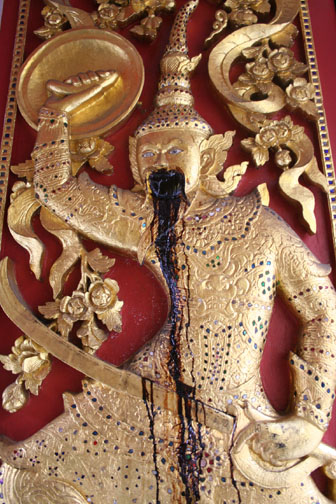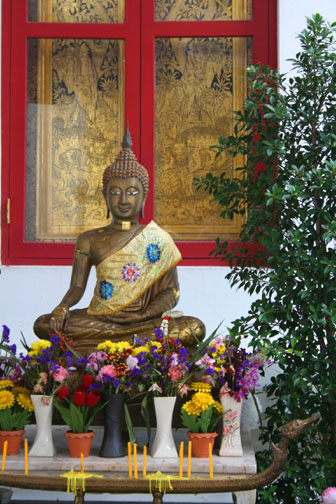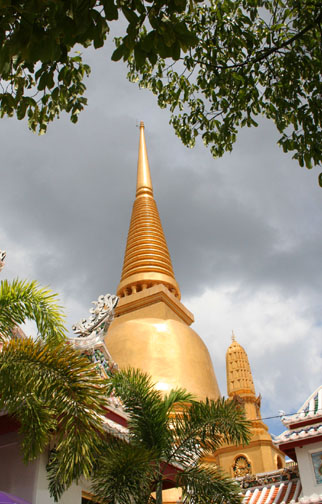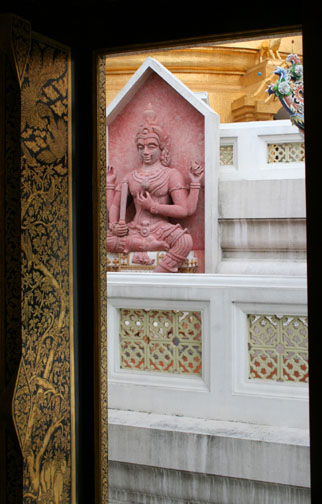For some reason, that the wat closest to the flea-ridden, backpacker haven of Khaosan Road hosts a humongous pack of vicious dogs just seems right. Even if they are made out of stone. That Khaosan Road’s blood sucking street vendors are also represented at the wat by guardians and gods with blood coursing from their mouths adds a bit more irony to the pot. Throw in an abundant supply of bottled take-away holy water – a counterbalance to the overpriced trinkets festooning the touri filled street just a block away – and you got yourself an award winning temple.
Wat Bowonniwet Wiharn Ratchaworawiharn is just around the corner from Khaosan Road. It’s to the backside of the ghetto, so I’d never run across it before. But with the danger of flooding on the horizon, our taxi driver decided to take the scenic route into Khaosan, providing a brief glimpse of the wat on the way. Lots of sandbags along Khaosan, zero water, and not too many open stores; everyone had buttoned down the hatches and fled, taking their stock with them. No problemo. With extra time on my hands it was but a quick jaunt down the block and around the corner to check out a new wat to add to my ever growing collection. And a cool one it turned out to be.
Wat Bowonniwet Wiharn Ratchaworawiharn is of the ‘white wall/red roof’ style of temple architecture. With numerous buildings spanning the complex’s lengthy interior, at first glance it doesn’t seem to offer much that you don’t see at pretty much any wat in town. But then you notice the abundance of temple dog statuary. For lack of being pedantic, I’m just gonna call them foo dogs here. And they are everywhere within the temple grounds. I’m also gonna quit calling the temple Wat Bowonniwet Wiharn Ratchaworawiharn in light of the length of its name as well as its multiple correct spellings, and just go with the appropriate diminutive of Wat Bow Wow.
There are several entrances into the temple’s complex, all through red doorways; the one we used quickly led us to the main ubosot. Filled at the time with worshipers (who undoubtedly were busy asking Buddha what it was they had done in a previous life that led to them having to deal with the scum of the world – otherwise known as backpackers – in this one) we checked the surrounding area out instead. And found a much more dramatic entrance. The one in line with the doors to the ubosot feature gilt adorned gods on its doors with a nice 3D effect: they both have blood gushing from their mouths. A gold statue in a small niche at that entrance has the same bloody countenance. That was one of those ‘huh’ moments and I asked my Thai friend with whom I was touring the wat for an explanation.
“It not real.”
Okay. Thanks for that.
Google offered up an alternative theory of what the gunk streaming from the guardians’ mouths is, and it fits in with the drugged-out backpackers of Khaosan just as nicely. In days of yore, gamblers came to the wat to garner good luck and to get lucky numbers for the lottery. The guardians on the doors are of Chinese design and it was assumed since (at that time) all the Chinese in Thailand were addicted to opium, the guardians would like a bit of the poppy too. So supplicants would rub black opium on their mouths to obtain their wishes. Huh. And if my friend’s call of ‘it not real’ is true, I’m gonna be real disappointed on my return visit.
Not as impressive is the entrance at the far end of the complex (closest to Khaosan Road) where a large bodhi tree grows encircled by a fenced cage. My friend was more forthcoming on this one and explained the tree had been planted by the King when he lived at the wat for a brief time during his years as a student and a member of the monkhood. The wat’s connection to King Bhumibol alone should tip you off to it’s importance. Several members of the royal family have served in the monkhood here, including Rama IV who served as chief abbot before ascending to the throne. The wat has also been home to three Supreme Patriarchs, a position loosely defined as head monk of Thai Theravada Buddhism.
Of a less stellar residency, Field Marshal Thanom Kittikachorn, who oversaw a decade of military rule in Thailand from 1963 to 1973 until public protests exploded into violence and forced him to step down, returned from exile in 1976 and settled in at Wat Bow Wow as a novice monk. His return sparked protests at Thammasat University which led to a massacre of demonstrators, followed by the Thai military seizing power from the elected civilian government. But then that was several coups ago and now is ancient history.

Inside the ubosot at Wat Bowonniwet Wiharn, sunlight illuminates the Buddhist imagery and worshipers alike.
I’m fascinated by the shuttered windows at wats, often times bearing religious scenes in gold. Perhaps it was just the right time of the day, but the ones at the ubosot at Wat Bow Bow provided an exceptional display letting in the sun’s rays to illuminate sections of the dark interior, nicely setting off the glittering gold Buddhas manning the altar area. Definitely a Kodak moment. There are two main Buddha statues in Wat Bow Wow’s ubosot, the smaller one is called the Phra Puttha Chinarat, and the larger one behind it is the Phra Suwannakhet. Both are historically significant Buddhas and are part of the temple’s draw, as are the series of murals painted on the chapel’s walls and window shutters.
In front of the altar a large drum holds small bottles of holy water visitors may take home with them (donation expected). I’d not seen Buddhist holy water before, but then ran across more the next day at the airport. There, a large tray holds small bottles for the taking in front of the Churning of the Milk Ocean statue, just after the security checkpoint (donations also expected but hardly ever given).
Behind the ubosot, the temple’s golden chedi soars into the sky. It’s a rather large chedi with golden statues of foo dogs and a few eagles surrounding it. There are narrow stairways that allow you to climb to its upper level, carpeted in extremely tacky green outdoor carpet which thanks to being in shadows tends to stay soggy, entrapping the gunk of hundreds of users over the years. (Not so much a recommendation, but a warning since you do have to kick off your shoes before heading upward.) Upstairs there are several flower and candle bedecked shrines and some great views over the rooftops of the wat’s outer buildings and temples. Around its groundfloor perimeter are a series of gargantuan bodhisattvas in pinks and white that add an Eastern Island effect to the scene.
Wat Bow Bow is a large temple complex with several other significant buildings, though its two main wiharns are not open to the public. Connected to, but just beyond its white stucco walls are several striking colonial styled buildings including the Phra Tamnak Phet, or Royal Diamond Residence. It was built by King Rama VI and once housed Thailand’s first printing press. Today it holds an art exhibit of monastic hierarchical fans designed by Prince Narissaranuwatiwong.
This area, interveined by small canals, fountains, and plenty of trees and flowers is a tranquil oasis surrounded by one of the busier areas of Bangkok and is also home to the temple’s monks. The temple is a center of the Thammayut Nikaya school of Thai Theravada Buddhism and small terraced houses surrounded by flowers make up the monks’ residence. Visitors are welcomed; you can sit with the monks as they study and have a conversation, or just watch them go about their daily lives.
There are numerous chapels and buildings strewn about the complex and several well-known Buddha images, including the Phra Dighayumahamongol, affectionately known as Luang Por Dam (Venerable Black Father) due to its dark color before gilding, the Phra Satsada Buddha, a reclining Buddha known as Phra Saiya, and a small but beautiful green stone Buddha from the Dvaravati period. There is a lot to see at Wat Bow Wow, it’s not one of those wats you can polish off in a half hour.
Wat Bow Wow is located at the corner of Bowonniwet Road and Phra Sumen Road. Admission is free, and the temple complex is open from 08:00-17:00 daily.







